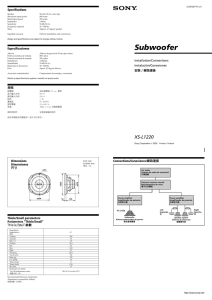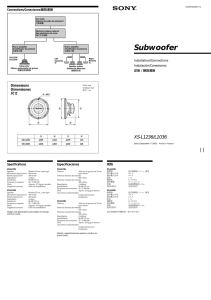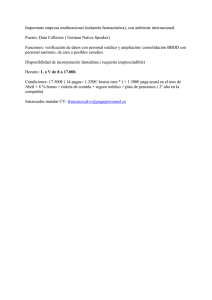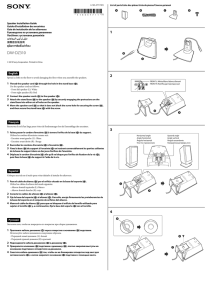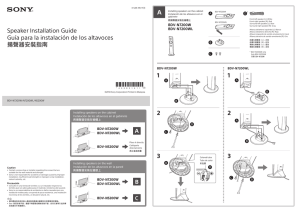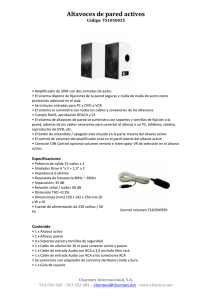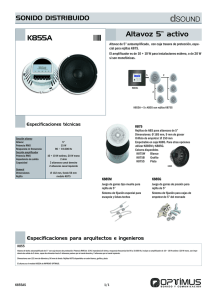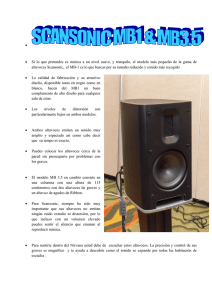S-A5 Speaker System
Anuncio
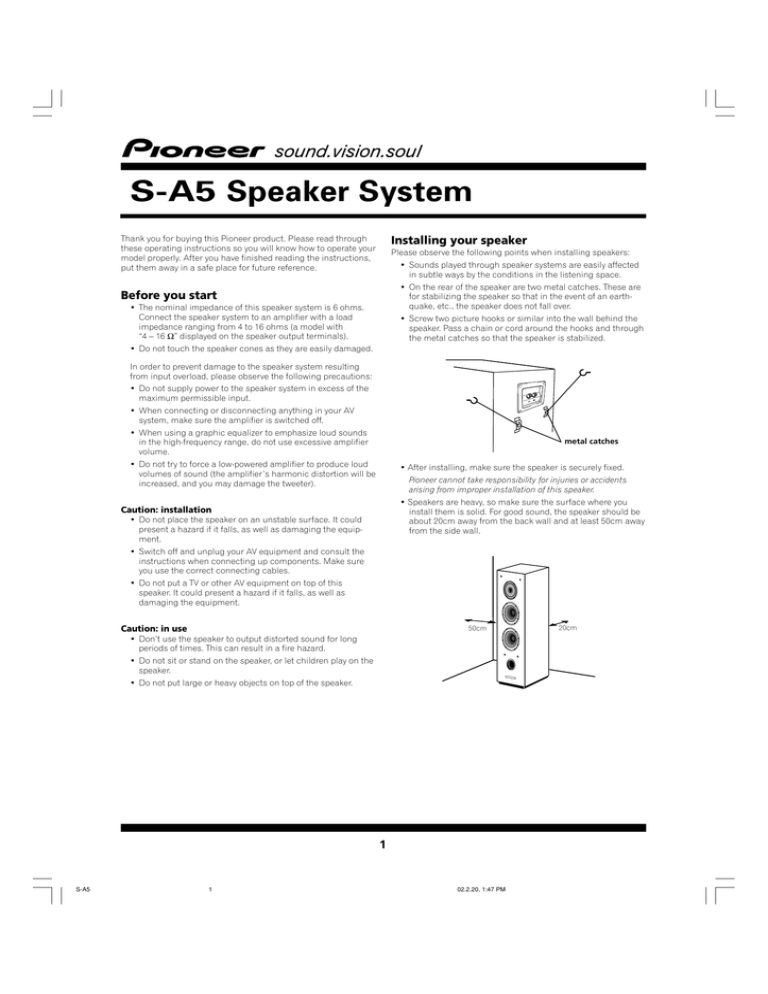
S-A5 Speaker System Thank you for buying this Pioneer product. Please read through these operating instructions so you will know how to operate your model properly. After you have finished reading the instructions, put them away in a safe place for future reference. Installing your speaker Please observe the following points when installing speakers: • Sounds played through speaker systems are easily affected in subtle ways by the conditions in the listening space. • On the rear of the speaker are two metal catches. These are for stabilizing the speaker so that in the event of an earthquake, etc., the speaker does not fall over. Before you start • The nominal impedance of this speaker system is 6 ohms. Connect the speaker system to an amplifier with a load impedance ranging from 4 to 16 ohms (a model with “4 – 16 Ω” displayed on the speaker output terminals). • Screw two picture hooks or similar into the wall behind the speaker. Pass a chain or cord around the hooks and through the metal catches so that the speaker is stabilized. • Do not touch the speaker cones as they are easily damaged. In order to prevent damage to the speaker system resulting from input overload, please observe the following precautions: • Do not supply power to the speaker system in excess of the maximum permissible input. • When connecting or disconnecting anything in your AV system, make sure the amplifier is switched off. • When using a graphic equalizer to emphasize loud sounds in the high-frequency range, do not use excessive amplifier volume. metal catches • Do not try to force a low-powered amplifier to produce loud volumes of sound (the amplifier’s harmonic distortion will be increased, and you may damage the tweeter). • After installing, make sure the speaker is securely fixed. Pioneer cannot take responsibility for injuries or accidents arising from improper installation of this speaker. • Speakers are heavy, so make sure the surface where you install them is solid. For good sound, the speaker should be about 20cm away from the back wall and at least 50cm away from the side wall. Caution: installation • Do not place the speaker on an unstable surface. It could present a hazard if it falls, as well as damaging the equipment. • Switch off and unplug your AV equipment and consult the instructions when connecting up components. Make sure you use the correct connecting cables. • Do not put a TV or other AV equipment on top of this speaker. It could present a hazard if it falls, as well as damaging the equipment. Caution: in use 50cm • Don’t use the speaker to output distorted sound for long periods of times. This can result in a fire hazard. • Do not sit or stand on the speaker, or let children play on the speaker. • Do not put large or heavy objects on top of the speaker. 1 S-A5 1 02.2.20, 1:47 PM 20cm • Place speakers equal distances from your listening position for good stereo sound. Use speaker cords of the same length for each speaker. Attaching the spikes A set of four metal spikes is supplied that you can use to isolate the speaker from the floor. We recommend using the spikes over the supplied non-slip pads as they will improve the sound of the speaker. 1 Spike Speaker base 50 – 60º Nut 2 • If you’re using these speakers for your TV sound, install them at equal distances either side of the TV and point them in the same direction as the TV. For each spike: • If the room has a lot of reverberation, we recommend hanging heavy fabric on the walls, and/or putting a carpet on the floor to damp the sound. For best results, cover walls completely. 2 Screw the spike into the base of the speaker. There are four holes for the spikes in the base of the speaker cabinet. 1 Screw the nut all the way onto the spike. 3 Place the speaker upright so that the spikes are resting on the spike bases on the floor. • Do not place the speaker where it will be in direct sunlight, and avoid positioning it near heaters and air conditioners. This may cause warping and discoloration of the speaker cabinet and damage the speakers. 4 Adjust the spike lengths by unscrewing them slightly from the speaker cabinet. Adjust so that the speaker is resting squarely on all four spikes. • The speaker is heavy. Placing it on an unstable surface is dangerous, and should be avoided. 5 Tighten the nut up against the base of the speaker. Attaching the non-slip pads A set of four self-adhesive non-slip pads are supplied that you can use in place of the spikes to provide some isloation and also prevent the speakers moving. Pioneer assumes no liability whatsoever for damages resulting from assembly, improper mounting, insufficient reinforcement, misuse of the product, acts of nature, etc. 1 Remove the backing tape of the non-slip pads and stick one in each corner on the base of the speaker. Speaker base 2 S-A5 2 02.2.20, 1:47 PM Connecting to an amplifier Detatching and replacing the front grille Before connecting to your amplifier, make sure that the amp is switched off. The front grille of this speaker system is removable. Proceed as follows: Use the supplied speaker cable to connect up the speakers. Make sure that you match up the speaker terminals on the speakers with those on your amplifier so that the positive (+) terminals and negative (–) terminals are paired. 1 Twist off the protective shielding on the ends of the speaker cable. Twist together any stray strands of speaker wire. 2 Unscrew the terminals on the speakers and insert the speaker wire as shown. Note which way up the grille goes 1 Use both hands to hold the bottom part of the grille, and pull it gently towards you. You will then be able to free the bottom part of grille. Striped half of speaker cable to positive (+) speaker terminal 2 Similarly, take hold of the top part of the grille, and pull it towards you; the whole grille will then be detached from the speaker system. Other half of speaker cable to negative (–) speaker terminal 3 To replace the grille, align the holes in the grille’s corners with the projections on the front of the speaker, and push each of the corners into place. 3 Connect the other end of the speaker cable to the speaker terminals on your amplifier. Magnetic shielding This speaker system is magnetically shielded. However, depending on the installation location, color distortion may occur if the speaker system is installed extremely close to the screen off a television set. You can also use banana plugs to connect up the speaker. • After connecting the plugs, pull lightly on the cables to make sure that the ends of the cables are securely connected to the terminals. Poor connections can create noise and interruptions in the sound. If this happens, turn off the television, then turn it on again after 15 to 30 minutes. If the problem persists, place the speaker system away from the television set. • If the cables' wires happen to be pushed out of the terminals, allowing the wires to come into contact with each other, it places an excessive additional load on the amp. This may cause the amp to stop functioning, and may even damage the amp. Cleaning the speaker cabinet With normal use, wiping with a dry cloth should be sufficient to keep the cabinet clean. If necessary, clean with a cloth dipped in a neutral cleanser diluted five or six times with water, and wrung out well. Do not use furniture wax or cleansers. Never use thinners, benzine, insecticide sprays or other chemicals on or near this unit since these will corrode the surfaces. 3 S-A5 3 02.2.20, 1:47 PM Specifications Enclosure ........................... Bass-reflex type magnetically shielded floorstanding speaker Configuration ............................................................................. 2-way Woofer .................................................................. 13 cm cone x2 Tweeter .................................................................... 2.5 cm dome Nominal impedance .................................................................... 6 Ω Frequency response .................................................... 31~42,000 Hz Sensitivity ................................................................88 dB/W (at 1 m) Allowable input Maximum input (EIAJ) ...................................................... 100 W Crossover frequency .............................................................. 2.5 kHz Exterior dimensions (mm) ............. 175 (W) x 895 (H) x 280 (D) mm Weight ..................................................................................... 17.2 kg Supplied accessories Speaker cable (2.5 m) .............................................................. x1 Spikes ........................................................................................ x4 Spike bases ............................................................................... x4 Non-slip pads ...................................................................... x1 set Operating instructions ............................................................. x1 Specifications and design subject to possible modification without notice, due to improvements. Real, natural wood is used in the construction of the speaker system cabinets. They feature a wonderful color and depth that is much more attractive than plastic veneers and similar materials. No two pieces of natural wood are exactly alike. Keep this point in mind as you enjoy these speakers. Frequency response and harmonic distortion Published by Pioneer Corporation. Copyright © 2002 Pioneer Corporation. All rights reserved. 4 S-A5 4 02.2.20, 1:47 PM Sistema de altavoces S-A5 Le agradecemos la compra de este producto Pioneer. Lea con atención este manual de instrucciones para aprender cómo utilizar adecuadamente este modelo. una vez que haya leído las instrucciones, guárdelas en un lugar seguro para poderlas consultar en el futuro. Instalación de los altavoces Le rogamos que respete las siguientes recomendaciones al instalar los altavoces: • Los sonidos que se reproduzcan a través de estos sistemas de altavoces se verán fácilmente afectados sutilmente por las condiciones del espacio de audición. Antes de comenzar • Verá dos colgadores metálicos en la parte posterior de los altavoces. Su propósito es estabilizar el altavoz para que en caso de que ocurra un terremoto, etc. el altavoz no se caiga. • La impedancia nominal de este sistema de altavoces es de 6 ohmios. Conecte el sistema de altavoces a un amplificador que tenga una carga de impedancia de 4 a 16 ohmios (es decir, un modelo en el que observe “4 -16 Ω” en los terminales de salida del altavoz). • Atornille dos ganchos o similar a la pared de detrás del altavoz. Pase una cadena o cable entre los ganchos y por los amarres metálicos para que el altavoz quede estabilizado. • No toque los conos de los altavoces porque podrían dañarse fácilmente. Para evitar daños al sistema de altavoces que podrían resultar de una sobrecarga en la entrada, le rogamos que siga estas precauciones: • No sobrealimente el sistema de altavoces más allá de la capacidad máxima permisible. • Al conectar o desconectar cualquier dispositivo de su AV, asegúrese de que el amplificador está apagado. amarres metálicos • Al usar un ecualizador gráfico para enfatizar los sonidos altos en la gama de frecuencias alta, no use un volumen excesivo en el amplificador. • Terminada la instalación, asegúrese de que el altavoz quede fijado con seguridad. • No intente forzar un amplificador de baja potencia para que produzca volúmenes altos de sonido (la distorsión armónica del amplificador se incrementará y puede dañar el altavoz de agudos). Pioneer no puede aceptar ninguna responsabilidad por lesiones o accidentes que puedan ocurrir por el mal montaje de los altavoces en una pared o en el techo. • Los altavoces son pesados, por lo que le rogamos que se cerciore de que la superficie sobre la que instala los altavoces es sólida. Para obtener unos buenos resultados acústicos, los altavoces deberían estar alejados unos 20 cm de la pared posterior y al menos 50 cm de las paredes laterales. Precaución: Instalación • No coloque el altavoz sobre una superficie inestable. Podría ser peligroso en caso de que cayera y podría dañarse el equipo. • Apague y desconecte su equipo AV y consulte las instrucciones cuando conecte los componentes. Asegúrese de que está utilizando los cables de conexión correctos. • No coloque un televisor ni ningún otro equipo AV encima del altavoz. Podría ser peligroso en caso de que cayera y podría dañarse el equipo. Precaución: en uso 50cm • No use el altavoz para reproducir sonidos distorsionados durante largos períodos de tiempo.Esto podría representar un peligro de incendio. • No se siente ni se ponga de pie, ni permita que los niños jueguen con el altavoz. • No coloque objetos grandes ni pesados encima del altavoz. 5 20cm • Sitúe los altavoces a unas distancias equivalentes desde su posición de audición para poder obtener un buen sonido estéreo. Use cables de altavoz de la mis longitud en cada altavoz. Acoplamiento de los tornillos punzantes se suministra un juego de cuatro tornillos punzantes metálicos que puede usar para aislar el altavoz del suelo. Recomendamos que use los tornillos punzantes sobre las almohadillas antideslizantes que se suministran porque mejorará el sonido del altavoz. Tornillo 1 punzante Base del altavoz 50 – 60º Tuerca 2 • Si está usando estos altavoces para obtener sonido de su televisor, instálelos a una distancia igual a cada lado del televisor y diríjalos en la misma dirección que el televisor. En cada tornillo punzante: • Si la sala sufre demasiada reverberación, le recomendamos que cuelgue una tela pesada en las paredes y/o enmoquete el suelo para amortiguar el sonido. Para obtener los mejores resultados, cubra las paredes totalmente. 2 Atornille el tornillo punzante hasta la base del altavoz. Hay cuatro orificios para los tornillos punzantes en la base del armario del altavoz. 1 Atornille la tuerca totalmente, hasta el fondo del tornillo punzante. 3 Coloque el altavoz de pie para que los tornillos punzantes descansen en las bases de los tornillos punzantes en el suelo. • No sitúe un altavoz donde pueda entrar en contacto con luz solar directa y evite colocarlo cerca de calefactores y aparatos de aire acondicionado. Esto puede provocar sonidos alabeados y decoloración del armario del altavoz y ocasionarle daños. 4 Ajuste las longitudes de los tornillos punzantes desatornillándolos ligeramente del armario del altavoz. Ajuste para que el altavoz descanse sobre los cuatro tornillos punzantes de modo equilibrado y niveladamente. • Estos altavoces son pesados. Colocarlos sobre una plataforma no adecuada es peligroso y siempre debería evitarse. 5 Apriete la tuerca contra la base del altavoz. Acoplamiento de las almohadillas antideslizantes Se suministran un juego de cuatro almohadillas autoadhesivas antideslizantes que puede utilizar en lugar de los tornillos punzantes para aislar y evitar también que se muevan los altavoces. Pioneer no asume ninguna responsabilidad por los daños que puedan ocasionarse al ensamblar o montar indebidamente, reforzar insuficientemente, usar inadecuadamente el producto, actos de la naturaleza, etc. 1 Quite la cinta de apoyo de las almohadillas antideslizantes y péguelas a cada una de las esquinas de la base de cada altavoz. Base del altavoz 6 Conexión a un amplificador Extracción y recambio de la parrilla frontal Antes de conectar a un amplificador, cerciórese de que el amplificador está apagado. La parrilla frontal de este sistema de altavoces es extraíble. Para extraerla, siga estas instrucciones: Use el cable del altavoz que se suministra para conectar los altavoces. Asegúrese de emparejar bien los terminales de los altavoces con los de su amplificador, de modo que los terminales positivos (+) y los negativos (_) queden emparejados unos con otros. 1 Trence las vainas protectoras de los extremos del cable de los altavoces. Trence cualquier filamento que pueda quedar suelto del cable de los altavoces. 2 Desatornille los terminales de los altavoces e inserte el cable del altavoz como se muestra en la ilustración. Observe en qué sentido va la parrilla 1 Usando ambas manos, sostenga la parte inferior de la parrilla y tire de ella hacia Ud. con suavidad. entonces podrá liberar la parte inferior de la parrilla. Mitad del cable de los altavoces que va al terminal positivo (+) del altavoces 2 Del mismo modo, tome la parte superior de la parrilla y tire de ella hacia Ud. y verá como se separa toda la parrilla del sistema de altavoces. Otra mitad del cable de altavoces que va al terminal negativo (_) del altavoces 3 para recambiar la parrilla, alinee los orificios de las esquinas de las parrillas con las proyecciones de la parte frontal del altavoz y empuje cada una de las esquinas en su sitio. 3 Conecte el otro extremo del cable de los altavoces a los terminales de altavoz de su amplificador. Protección magnética Este sistema de altavoces tiene protección magnética. No obstante, y dependiendo del lugar de instalación, puede haber distorsiones del color si el sistema de altavoces se instala demasiado cerca a la pantalla de un televisor. También puede usar conectores curvos para conectar los altavoces. Si esto ocurriera, apague el televisor y vuélvalo a encender transcurridos entre 15 y 30 minutos. Si persiste el problema, aleje el sistema de altavoces del televisor. • una vez conectados los enchufes, estire ligeramente de los cables para asegurarse de que sus extremos quedan conectados con seguridad a los terminales. Unas malas conexiones pueden crear ruidos e interferencias en el sonido. Limpieza del armario del altavoz Con usos normales, la limpieza con un paño seco debería ser suficiente para mantener limpio el armario. En caso de necesidad, limpie con un paño mojado en un limpiador neutro diluido cinco o seis veces en agua y escurra bien. No use ceras para muebles ni limpiadores fuertes. • Si los cables se salieran de los terminales, haciendo que los cables entren en contacto los unos con los otros, la carga sobre el amplificador aumentará excesivamente. Esto puede causar que el amplificador deje de funcionar e incluso puede dañar el amplificador. Nunca use diluidores, benzina, insecticidas u otros productos químicos en o cerca de la unidad puesto que corroerán la superficie. 7 Especificaciones Armario ..................... Altavoz de suelo con protección magnética con reflejo de graves Configuración ............................................................................ 2 vías Altavoces de graves .......................... Dos de 13 cm tipo cónico Altavoz de agudos ........................................ 2,5 cm tipo cúpula Impudencia nomina ..................................................................... 6 Ω Respuesta de la frecuencia ........................................ 31~42,000 Hz Sensitividad ............................................................. 88 dB/W (a 1 m) Entrada permisible Entrada máxima (EIAJ) ..................................................... 100 W Frecuencia de cruce .............................................................. 2.5 kHz Dimensiones exteriores (mm) ........ 175 (An) x 895 (Al) x 280 (Lg) mm Peso ............................................................. 17,2 kilos (cada altavoz) Accesorios suministrados Cable del altavoz(2,5 m) ............................................................ 1 Tornillos punzantes .................................................................... 4 Bases de los tornillos punzantes ............................................. 4 Almohadillas antideslizantes ......................................... 1 juego Manual de instrucciones .......................................................... 1 Las especificaciones y el diseño están sujetos a posibles modificaciones sin previo aviso debido a la política de continuas mejoras de la empresa. Se usa madera real y natural en la fabricación de los armarios del sistema de altavoces. Por ello, el color y profundidad de su acabado es agradable y mucho más atractivo que los chapados plásticos y materiales similares. No hay dos piezas de madera que sean totalmente iguales. Recuérdelo mientras disfruta de sus altavoces. Frecuencia de la respuesta y distorsión armónica Nivel de salida (dB) Frecuencia de la respuesta/distorsión armónica 3rd armónica 2nd armónica Publicado por Pioneer Corporation. Copyright © 2002 Pioneer Corporation. Todos los derechos reservados. 8 S-A5揚聲器系統 感謝您購買本先鋒產品。請仔細閱讀使用說明,這樣您將知道如 何正確使用本機型。閱讀完本說明書後,請將它放在安全的地方 以供日後查閱。 安裝揚聲器 在安裝揚聲器時敬請注意以下幾點︰ ÷ 通過揚聲器系統播放的聲音很容易受到收聽環境條件細微的 影響。 ÷ 在揚聲器後部有兩個金屬扣鎖用於穩定揚聲器,這樣,在地 開始使用前 震等情況下揚聲器不會傾倒。 ÷ 本揚聲器系統的標稱阻抗為6Ω。將本揚聲器系統連接至一負 載阻抗為4到16Ω的放大器(揚聲器輸出端子上有"4-16Ω"顯 示標記的型號)。 ÷ 將兩個圖畫掛鉤或類似物品旋入揚聲器背後的牆壁。將一根 鏈條或者繩線繞住掛鉤並穿過金屬掛鉤用以穩定揚聲器。 ÷ 請勿觸摸揚聲器紙盆部分,因為這些部分容易損壞。 為了防止輸入過載而導致揚聲器系統損壞,請注意以下幾點注 意事項︰ ÷ 請勿對揚聲器系統提供超出最大允許輸入功率的電源。 ÷ 在連接或者斷開AV系統時,請確保關閉放大器。 ÷ 當使用圖像等化器在高頻范圍強調響亮的音色時,請勿使用 過度的放大音量。 金屬掛鉤 ÷ 請勿試圖用低功率放大器來播放響亮的音色(放大器的諧波 失真將加劇,還可能損壞您的高音揚聲器)。 ÷ 安裝完畢後,請確保揚聲器已牢牢固定住。對於因為揚聲器 的不當安裝而引起的損傷或事故,先鋒將不承擔任何責任。 ÷ 揚聲器較為沉重,請確保安裝處有堅固的表面。要得到良好 警告︰安裝 的音質,揚聲器應置於距離後牆 20 cm以及距離側牆 50 cm 的地方。 ÷ 請勿將揚聲器放置於不穩定的平面上,這可能導致設備傾倒 和損壞。 ÷ 當要連接所有設備時,關閉並拔下AV設備,請參閱使用說明 書。請確保您使用的是正確的連接電纜。 ÷ 請勿將電視機或者其它AV設備放置於揚聲器頂部,這可能導 致設備傾倒與損壞。 警告︰使用中 ÷ 請勿使揚聲器長時間輸出失真聲音,這可能導致著火的危 50cm 險。 ÷ 請勿坐在或者站在揚聲器之上,也勿讓兒童在揚聲器上面玩 耍。 ÷ 請勿將大件或沉重的物體放置於揚聲器頂部。 9 20cm ÷ 將兩個揚聲器置於與收聽位置等距的位置以獲取良好的立體 聲效果。對每個揚聲器都使用相等長度的電線。 安裝長螺釘 本揚聲器附帶一套四枚長螺釘,可用於隔離揚聲器和地板。建議 在防滑襯墊上使用長螺釘,這樣將增進揚聲器的音效。 1 長螺釘 揚聲器底座 50 – 60º 螺母 2 對於每一個長螺釘: ÷ 如果您要使用揚聲器來播放電視的聲音,請將揚聲器安裝在 電視機兩側的等距位置,且其朝向與電視機方向相同。 ÷ 如果房間中有大量混響,建議您在牆面上懸掛厚重的織物, 或者在地板上放置地毯以削弱聲音。為取得最佳效果,請將 牆壁完全覆蓋。 ÷ 請勿將揚聲器放置於陽光直射的地方,並避免將其放置於加 熱器以及空調旁。這可能導致揚聲器外殼的翹曲或者變色, 進而損壞揚聲器。 ÷ 揚聲器較為沉重。將其放置於不穩定的平面上比較危險,必 1 將螺母旋緊在長螺釘上。 2 將長螺釘旋入揚聲器底座。 揚聲器外殼底座上有四個長螺釘孔。 3 將揚聲器垂直放置,以使長螺釘與地板上的長螺釘腳嚙合。 4 通過輕微的旋動來調整長螺釘的長度。 調整長螺釘長度直到揚聲器正好擱置於所有四個長螺釘上。 5 將螺母旋緊至揚聲器底座上。 須避免。 安裝防滑襯墊 對於任何因組裝、不當安裝、加固不足、產品誤操作以及自 然界因素而造成的損壞,先鋒不予承擔任何責任。 本揚聲器附帶有兩套四組防滑襯墊,可使以隔離揚聲器並防止其 移動。 1 撕去防滑襯墊底帶,將襯墊貼放在揚聲器底座每個角上。 揚聲器底座 10 連接至放大器 拆下並更換前部護網 在連接至放大器之前,請確保關閉放大器。 本揚聲器系統的前部護網可拆除。請如下進行操作︰ 使用附帶的揚聲器電纜來連接揚聲器。請確保揚聲器上的揚聲器 端子與放大器上的揚聲器端子相匹配,即正極(+)端子與正極 端子配對,負極(-)端子與負極端子配對。 1 剝掉揚聲器電纜末端的絕緣套。將雜散的金屬內芯捻攏在一 起。 2 旋下揚聲器上的端子並如圖所示插入揚聲器電纜。 注意將護網面 朝外放置 將帶條紋的揚聲 器電纜連至正極 (+)揚聲器端子 1 用雙手握住護網的底部,並輕輕朝自己的方向拉曳。這樣就 可以松開護網的底部。 2 相似地,用雙手握住護網的頂部,並朝自己的方向拉曳。這 樣就可以將整個護網從揚聲器上拆下。 而另一根揚聲器電纜連至 負極(-)揚聲器端子 3 3 更換護網時,先將護網角上的小孔對準揚聲器前部的突起, 再將各角邊推送至正確的位置。 將揚聲器電纜的另一端連至放大器的揚聲器端子。 防磁功能 揚聲器系統具防磁功能。但在某些安裝位置,如揚聲器系統安裝 在離電視機屏幕極其近的位置時,可能會導致色彩失真。 您還可以使用香蕉型插頭連接揚聲器。 ÷ 在連接上插頭後,輕輕拉曳電纜以確保電纜末端已牢固連接 此時,請關閉電視機,並於 15 至 30 分鐘後再次開啟。如果問 題仍舊存在,請將揚聲器系統遠離電視機放置。 在端子上。連接不良可能導致噪聲以及聲音的中斷。 ÷ 如果電纜的電線無意中被拉出端子並互相接觸,將對放大器 產生過高的額外負載。這可能導致放大器停止工作,甚至損 壞放大器。 清潔揚聲器外殼 一般情況下用干布擦拭足以使外殼保持清潔。如果有必要,先用 布蘸取以五到六倍水稀釋過的中性清潔劑並絞干,再進行清潔。 請勿使用家具蠟或者清潔劑。 請勿對本機使用稀釋劑、苯、殺虫噴劑或者其它化學物品,也勿 將它們放在本機附近,否則可能會腐蝕設備表面。 11 頻率響應以及諧波失真 機殼 ....................... 低音反射型防磁式落地式揚聲器 配置 ............................................... 2 路 低音揚聲器 ............................. 13 cm 錐形 x 2 高音揚聲器 ............................. 2.5 cm 球頂型 額定阻抗 ........................................... 6 Ω 頻率響應 .................................. 31~42,000 Hz 靈敏度 ............................. 88 dB/W(在 1 m 時) 允許輸入 最大輸入(EIAJ) ............................... 100 W 分隔頻率 ........................................ 2.5 kHz 外形尺寸(mm) ........ 175(寬)×895(高)×280(深)mm 重量 ............................................ 17.2 kg 附件 揚聲器電纜(2.5 m) ............................... x1 長螺釘 ............................................ x4 長螺釘腳 .......................................... x4 防滑襯墊 ....................................... x1 套 使用說明書 ........................................ x1 頻率響應/諧波失真 輸出音壓(dB) 規格 第三諧波 第二諧波 如果規格與設計因產品改進而有所變更,恕不另行通知。 先鋒公司出版。 本揚聲器系統外殼使用的是天然原木。其色彩艷度和濃度比塑膠 飾面以及其它類似材料更富魅力。但在使用這些揚聲器時,敬請 注意,天然原木不可能完全相似。 版權 © 2002 先鋒Corporation。 保留所有權利。 Published by Pioneer Corporation. Copyright © 2002 Pioneer Corporation. All rights reserved. PIONEER CORPORATION 4-1, Meguro 1-Chome, Meguro-ku, Tokyo 153-8654, Japan, TEL: [03] 3494-1111 PIONEER ELECTRONICS [USA] INC. P.O. BOX 1540, Long Beach, California 90801-1540, U.S.A. PIONEER ELECTRONICS OF CANADA, INC. 300 Allstate Parkway, Markham, Ontario L3R OP2, Canada PIONEER EUROPE NV Haven 1087, Keetberglaan 1, B-9120 Melsele, Belgium TEL: 03/570.05.11 PIONEER ELECTRONICS AUSTRALIA PTY. LTD. 178-184 Boundary Road, Braeside, Victoria 3195, Australia, TEL: [03] 9586-6300 PIONEER ELECTRONICS DE MEXICO S.A. DE C.V. San Lorenzo 1009 3er Piso Desp. 302 Col. Del Valle Mexico D.F. C.P. 03100 TEL: 55-5688-5290 <TSWZF/02C00001> Printed in China <SRD1237-A>
